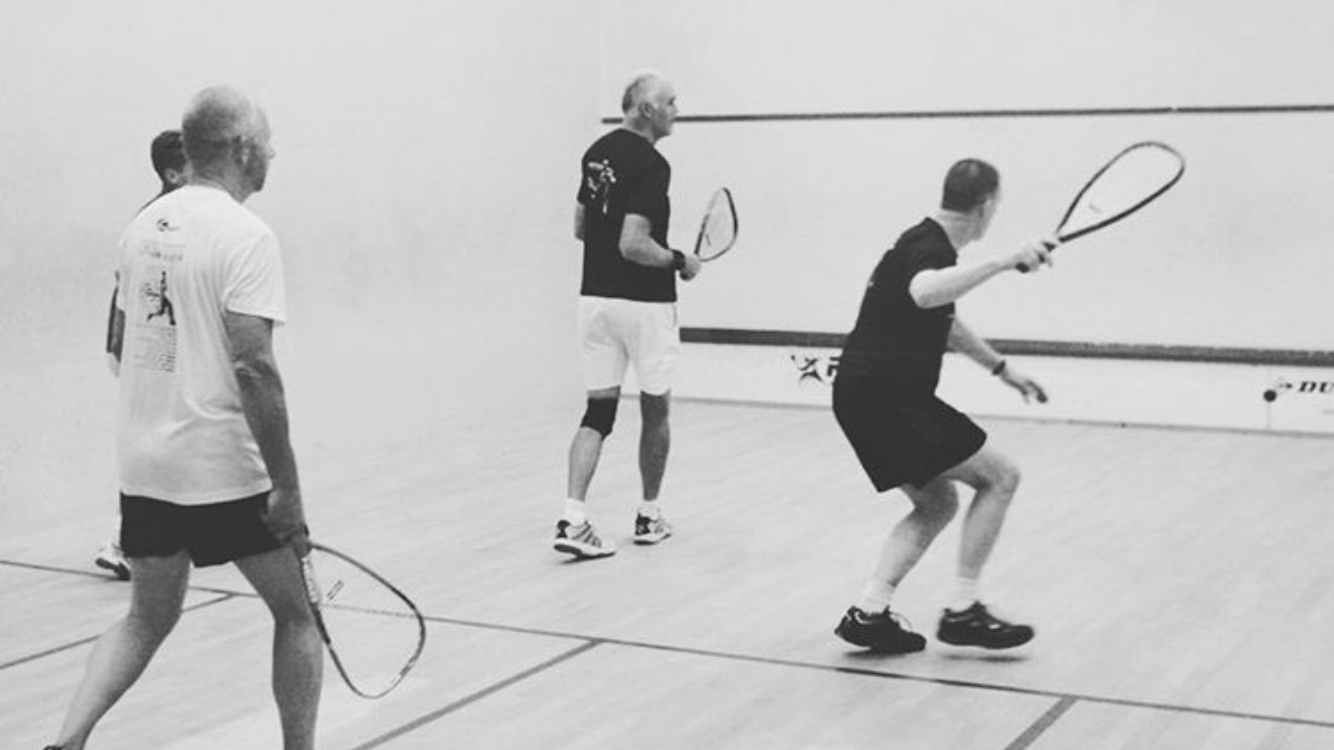Racketball Doubles Rules
The RULES of DOUBLES are the same as for the SINGLES game with the following alterations:
a. SIDES:
Sides shall consist of two players each.
b. WARM-UP:
The sides may warm up separately or together. Either side may request a separate
warm-up that lasts three minutes, immediately prior to the start of the match. If the
sides warm-up together it will last five minutes. The right to warm-up first when
separate shall be decided by the spin of a racket.
c. SERVER:
Each side nominates its server for the first game. That player serves for the entirety
of game one and game three in a five game match. The other player serves for game
two and game four (if played). In the final game (3rd or 5th) when the first side's
score reaches "five", the server changes for each team.
d. RETURN OF SERVICE & SUBSEQUENT PLAY:
At the beginning of each game, each side shall designate one of its players to receive
service in the right-hand service court and the other to receive service in the lefthand
service court. Throughout the course of such game, the service must be
received by the players so designated.
Only the Receiver may be positioned in the service court opposite the Server's service
court.
Until the ball has been touched or has hit the floor twice, it may be struck at any
number of times by either or both players on a side, in rotation.
(N.B. The order of striking shall be: The Server, the Receiver, the Server's partner,
the Receiver's partner).
e. LET:
If either player on the striking side is inadvertently hindered by either of his
opponents from reaching or striking at the ball, a let shall be allowed.
Note to Referees: Under rule 12of the Singles game, where interference has occurred
and the player has made every effort to avoid causing it, a let shall be allowed and
the Referee shall not consider whether a winning stroke has been prevented. This
shall not affect the Referee's duties in awarding strokes, as otherwise required in
Rule 12 of the "Singles Game".
NOTES ON LETS & STROKES:
If either player on the striking side is inadvertently hindered by either of their opponents
from reaching or striking the ball, a Let shall be allowed.
If, in the opinion of the Referee, interference to the striker is unnecessary or created, the
referee shall stop play and award a point to the hindered side.
Crowding shall also be penalised by the award of a point. If a service or return hits one
of the striker's opponents before reaching the front wall, it shall be a Let provided that
the service or return would have been good. If the service or return would not have been
good the striker's side shall lose the rally.
If a return hits the striker's partner, the other side wins the point.
NOTES ON MOVEMENT PATTERNS:
The movement patterns for Racketball Doubles differ greatly to that of Singles / Squash Doubles. Because of the alternate shot hitting aspect of it you can't just move straight to the T like you would do normally. The key idea is to maintain a rotation of players, first moving to the back door after you have played your shot, then gradually forward to the T as your next shot turn comes around.
This is excellently explained and demonstrated in this World Squash video put together by Patrick Osborn, Mark Fuller and John Cordeaux, well worth a watch to help you get to grips with it: www.youtube.com/watch?v=c_iV2b6hWz8&t=587s
Please also take a look at this second video put together by the guys outlining the general basics of the game, from serving onwards! https://www.youtube.com/watch?v=c_iV2b6hWz8
The RULES of DOUBLES are the same as for the SINGLES game with the following alterations:
a. SIDES:
Sides shall consist of two players each.
b. WARM-UP:
The sides may warm up separately or together. Either side may request a separate
warm-up that lasts three minutes, immediately prior to the start of the match. If the
sides warm-up together it will last five minutes. The right to warm-up first when
separate shall be decided by the spin of a racket.
c. SERVER:
Each side nominates its server for the first game. That player serves for the entirety
of game one and game three in a five game match. The other player serves for game
two and game four (if played). In the final game (3rd or 5th) when the first side's
score reaches "five", the server changes for each team.
d. RETURN OF SERVICE & SUBSEQUENT PLAY:
At the beginning of each game, each side shall designate one of its players to receive
service in the right-hand service court and the other to receive service in the lefthand
service court. Throughout the course of such game, the service must be
received by the players so designated.
Only the Receiver may be positioned in the service court opposite the Server's service
court.
Until the ball has been touched or has hit the floor twice, it may be struck at any
number of times by either or both players on a side, in rotation.
(N.B. The order of striking shall be: The Server, the Receiver, the Server's partner,
the Receiver's partner).
e. LET:
If either player on the striking side is inadvertently hindered by either of his
opponents from reaching or striking at the ball, a let shall be allowed.
Note to Referees: Under rule 12of the Singles game, where interference has occurred
and the player has made every effort to avoid causing it, a let shall be allowed and
the Referee shall not consider whether a winning stroke has been prevented. This
shall not affect the Referee's duties in awarding strokes, as otherwise required in
Rule 12 of the "Singles Game".
NOTES ON LETS & STROKES:
If either player on the striking side is inadvertently hindered by either of their opponents
from reaching or striking the ball, a Let shall be allowed.
If, in the opinion of the Referee, interference to the striker is unnecessary or created, the
referee shall stop play and award a point to the hindered side.
Crowding shall also be penalised by the award of a point. If a service or return hits one
of the striker's opponents before reaching the front wall, it shall be a Let provided that
the service or return would have been good. If the service or return would not have been
good the striker's side shall lose the rally.
If a return hits the striker's partner, the other side wins the point.
NOTES ON MOVEMENT PATTERNS:
The movement patterns for Racketball Doubles differ greatly to that of Singles / Squash Doubles. Because of the alternate shot hitting aspect of it you can't just move straight to the T like you would do normally. The key idea is to maintain a rotation of players, first moving to the back door after you have played your shot, then gradually forward to the T as your next shot turn comes around.
This is excellently explained and demonstrated in this World Squash video put together by Patrick Osborn, Mark Fuller and John Cordeaux, well worth a watch to help you get to grips with it: www.youtube.com/watch?v=c_iV2b6hWz8&t=587s
Please also take a look at this second video put together by the guys outlining the general basics of the game, from serving onwards! https://www.youtube.com/watch?v=c_iV2b6hWz8


